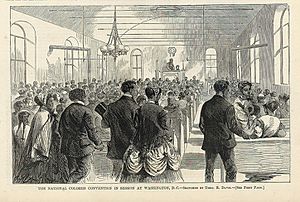Hezekiah Grice facts for kids
Quick facts for kids
Hezekiah Grice
|
|
|---|---|

A National Colored Union Convention, one of a series of conferences that Grice co-founded
|
|
| Born | c. 1801 |
| Died | 1863 |
| Nationality |
|
| Occupation |
|
| Known for |
|
Hezekiah Grice (around 1801–1863) was an important American and Haitian activist, inventor, and businessman. He was known for his political work in Baltimore in the early 1800s.
While working as a machinist in Baltimore, he was one of the first people to suggest holding a National Negro Convention. This meeting would discuss if African Americans should move away from the United States. This idea helped start the Colored Conventions Movement. Grice also played a key role in creating the Legal Rights Association. This group helped make citizenship rights clearer in America. It also pioneered new ways to fight for civil rights. Later, Grice moved to Haiti where he could become a full citizen. There, he became a successful tradesman and a trusted friend of Faustin Soulouque.
Contents
Early Life and Education
Hezekiah Grice was born in rural Calvert County, Maryland, around 1801. Historians believe he was born free, even though Maryland was a slave state at the time.
Despite the challenges, Grice received a good education. He became a skilled machinist. When he was young, he moved to Baltimore. Grice was known for his talent in math and as an inventor. He also spoke French very well. As he became more involved in politics, Grice worked with important abolitionist writers like William Lloyd Garrison.
Fighting for Rights
Hezekiah Grice was a dedicated activist and businessman in Baltimore. He worked during a time when many African American groups were thinking about moving away from the United States. They wanted to go to countries where Black people had more freedom.
The First National Convention
Around 1830, many African American activists discussed moving to Canada. This idea came after the Cincinnati riots of 1829. It was also a response to groups like the American Colonization Society trying to make Black Americans leave for Liberia.
Grice is often credited with being the first to call for a national meeting to discuss moving to Canada. His leadership was very important in making this meeting happen. He sent letters to Black leaders across the United States. The meeting was officially called by Bishop Richard Allen of Philadelphia.
This meeting became the first National Negro Convention. It took place from September 15 to 24, 1830, at the Mother Bethel A.M.E. Church in Philadelphia. The convention discussed if African Americans should move away from the U.S. They also talked about where they could go, like Canada.
Even though the 40 attendees did not fully agree, this convention was a big step. It showed how African American activists could work together to fight for their rights. It also started the larger Colored Conventions Movement. The meeting also suggested ways to get citizenship rights and practical skills like mechanical trades. Grice attended at least one more National Negro Convention in 1832.
The Legal Rights Association
Grice focused much of his activism on the fact that free African Americans did not have full citizenship rights. To understand how their rights were being denied, Grice helped start the Legal Rights Association. He co-founded it with William J. Watkins, Sr. and James Deaver.
This group was likely the first legal rights convention for African Americans. They continued the work of the 1830 Convention. The Legal Rights Association studied what rights African Americans should have and how those rights were being taken away. It became clear that many white lawyers and lawmakers wanted to remove free African Americans from the country entirely.
Life in Haiti
Grice did not stay in the United States for long after his activism. In 1834 or 1835, he decided to move from Baltimore to Port-au-Prince, the capital of Haiti. He moved because he wanted to gain the full citizenship rights that the United States had refused him. He believed he would not get these rights in America anytime soon.
In Haiti, he started a family. He became known as a skilled worker because of his expertise as a machinist. Grice was well-known to the country's leaders. He became a trusted friend of Faustin Soulouque, who was a ruler in Haiti. Grice was especially famous in Haiti for inventing things related to making sugar. Although Grice never moved back to the United States, he did visit. The Haitian government sent him to New York to buy machine parts for his sugar manufacturing inventions.
His Family
Hezekiah Grice had eleven children: six sons and five daughters. Most of his children were likely born in Haiti. By 1867, some of his sons and daughters had moved to America. All of his children were thought to speak French as their first language and were also educated in English.
One of his sons, George Grice, became a dentist in New York. Another son, Francis Grice, moved to San Francisco. Francis Grice was a sculptor and wrote about Haiti's right to govern itself. Grice's daughter Elizabeth Grice was the first wife of the abolitionist preacher William Douglass.

